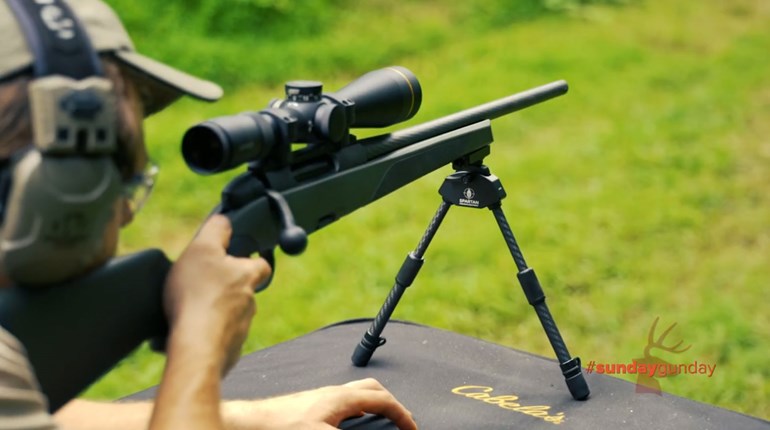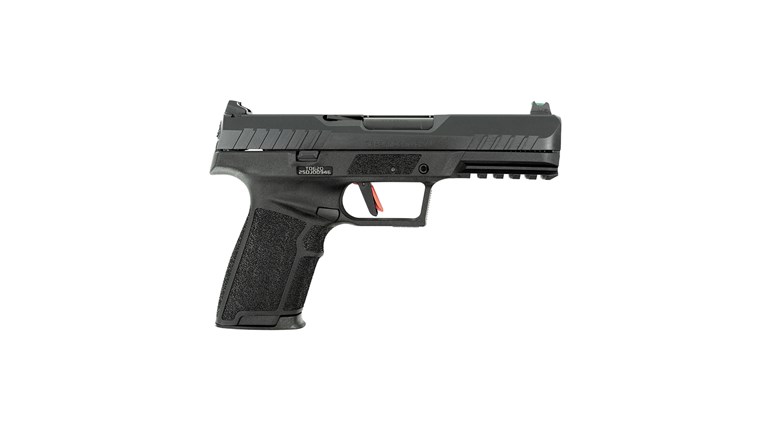
From the archives: Joseph B. Roberts, Jr., and Mike Nischalke’s match report from the 2002 Bianchi Cup National Action Pistol Championship. That year, Doug Koenig won his sixth Bianchi Cup title. Read our coverage below as published in the September 2002 issue of Shooting Sports USA.
Koenig Three-Peats Bianchi Cup
Story by Mike Nischalke and Joseph B. Roberts, Jr.
Walking off the mover, gear bag in hand, the uncharacteristically surprised look on his face said it all.

“Well, where’d it hit?” asked 33-year old Doug Koenig, who knew his two-year domination of NRA Action Pistol might have instantly ended.
Those he asked—a handful of top competitors—reflected the same bewildered look. They all knew the young champion may very well have thrown a shot out of the 10-ring and into the eight only moments earlier, nixing all hope for a three-peat, as well as an unprecedented sixth national championship. This, after all, was the Bianchi Cup, and dropping two points here was no better than shooting into thin air as far as winning this championship was concerned.
Following behind Koenig a few moments later, the range officer interrupted the silence as he dropped the four tombstone targets on the table. The first three, noticeably near perfect, were quickly slid aside to make room for the telltale target. There it was: Perched precariously on the edge of the 10-ring was a moly-rimmed hole.
“That’s an eight screaming to get in,” Koenig said.
It must have screamed loud enough, because sure enough, that thin perforated line in the target—in this case dividing victory and defeat—had been breached by the marksman’s .38-caliber bullet. Once again, the Bianchi Cup belonged to Koenig.
Alburtis, Pennsylvania, resident Koenig has always had a thing about firsts. He became the first Bianchi Cup champion to win the tournament with a perfect 1920 score. In doing so, he was also the youngest shooter to have won it. Last year, he was the first five-time winner and this year he became the first six-time winner of the NRA Bianchi Cup National Action Shooting Championship. Once again, he did it with a perfect 1920 score and a total of 184 tie-breaking Xs. Koenig’s 2002 victory came up one X shy of the course record he co-holds with 1999 Bianchi Cup Champion Bruce Piatt. The tournament, the 24th in the history of the competition, was conducted May 22-25, 2002, at the former Chapman Academy range, now operated by the Green Valley Rifle and Pistol Club of Columbia, Missouri.

In a contest in which “down one” has come to refer to a contender’s X-count, Koenig started his 2002 run “down.” He posted a 480 clean score on the first match fired, the Barricade Event, with 47 Xs—down one. Chief rival, New Jersey lawman Bruce Piatt, fired a perfect 480-48X, as did 16-year Bianchi Cup veteran George Mowbray, of Lake Charles, Louisiana. Though Koenig had challengers for the entire contest (the top five finishers posted 1920-point clean scores), his final triumph was never out of the question. He finished the three-day tournament at the top of the lists, with a 10-X margin.
When a fellow competitor quipped that he might need to enlarge his trophy room to accommodate a sixth Bianchi Cup, Koenig responded, “I can do that.”
Other victors in this year’s Bianchi Cup Action Shooting Championship included Vera Koo, a businesswoman from Atherton, California, who took up shooting as a way to relax. She won her third women’s crown with a score of 1905-151X. Her victory was a squeaker, though—a tie with U.S. Army Sgt. Julie Goloski of the Fort Benning, Georgia-based Army Marksmanship Unit. Goloski, the 1999 Army Athlete of the Year, posted an equal score but fell short in Xs fired at the longest ranges in the contest—a standard means of deciding ties.
Young shooters also prospered in the 2002 Bianchi Cup. Mitch Conrad, in his last year as a junior-category competitor, overcame a determined challenge by Australia’s Josh Sweeny and took the High Junior honors with a score of 1903-166X.
Senior laurels went to a 10-year Bianchi veteran, retired airline pilot Sam Baiocco, of Colleyville, Texas, with a score of 1911-156X. Baiocco’s tally topped those in a field of 14 senior shooters.

Since 1998, a second contest has been held as part of the Bianchi Cup National Action Pistol tournament, the Stock Firearm National Championship. Stock firearms are defined by NRA Action Shooting rules as essentially unmodified firearms, part of a production run of 1,000 or more pieces, available on the market for 12 months or longer. Stock firearms may be fitted with custom grips and sights similar to those found on unmodified arms. They may also be modified internally to improve functioning and accuracy. Positions and shooting techniques used by competitors in the Stock Firearm Championship are somewhat different than those used by competitors in the open contest.
The 2002 Stock Firearm National Champion was Rob Leatham of Mesa, Arizona. Leatham, a world-class shooter in International Practical Shooting Confederation competition and the 1984 Bianchi Cup winner, posted a Stock Firearm-winning score of 1884-136X. This victory was Leatham’s second Stock Championship. Second honors went to speed-shooting record holder Jerry Miculek, of Lafayette, Louisiana, with a score of 1872-129X. In addition, Germany’s Marc Kleser took third with 1870-122X.
Winners in the 2002 NRA-Bianchi Cup Action Shooting Tournament shared a prize package valued at approximately $250,000.
2002 BIANCHI CUP NATIONAL ACTION SHOOTING CHAMPIONSHIP LEADERBOARD
National Action Shooting Championship
- Doug Koenig, 1920-184X
- Mike Voigt, 1920-174X
- Don Golembieski, 1920-172X
- Jens Bork, 1920-169X
- Justin Blackburn, 1920-160X
National Stock Firearm Championship
- Rob Leatham, 1884-136X
- Jerry Miculek, 1872-129X
- Marc Kleser, 1870-122X
Open Championship Category Winners
- High Woman: Vera Koo, 1905-151X
- High Junior: Mitch Conrad, 1903-166X
- High Senior: Sam Baiocco, 1911-156X
- High Lawman: Bruce Piatt, 1918-176X
- High Revolver: Masashi Yada, 1914-136X
2002 BIANCHI CUP FORMAT
Four matches, each worth 480 points for a total of 1920 points, comprise the Bianchi Cup championship aggregate. Those four are:
MATCH I
Shooters draw and fire on a pair of Bianchi silhouettes within a time limit that varies from three seconds (for one shot on each silhouette) at seven yards to 15 seconds (for three shots per silhouette) at 50 yards. Firing includes use of the unsupported weak hand for one string at 10 yards.
MATCH II
Contestants draw and fire strings of six shots at a Bianchi silhouette, within a time limit that increases according to the increasing range. Shooting is done from the left and right-hand side of a barricade.
MATCH III
A Bianchi silhouette is pulled across a 60-foot-wide opening both right to left and left to right, in six-seconds per run. Shooters draw and fire at the moving silhouette, six shots per run at 10 yards, three shots per run at 15 and 20 yards, and two shots per run at 25 yards.
MATCH IV
The Falling Plate Event is essential a rapid-fire silhouette match. The targets are eight-inch-diameter steel plates set atop four-foot-high steel racks. In competition, shooters draw and fire on a rack of plates each of which must fall to be counted as hits. Plates are scored hit or miss.
Note: CMP now conducts the Bianchi Cup. The 2025 Bianchi Cup will kick off in Columbia, Missouri, on May 20. —Ed.

































